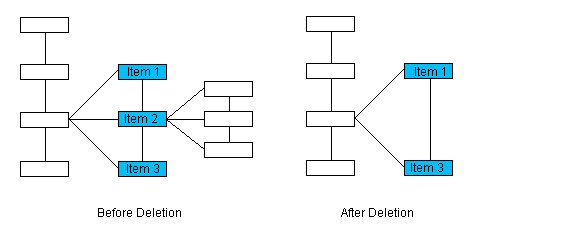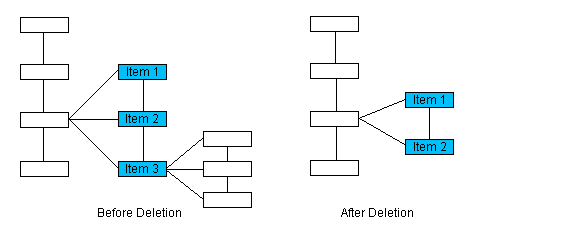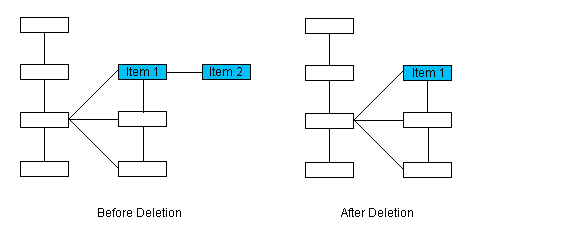L_DicomDeleteElement
#include "Ltdic.h"
L_LTDIC_API pDICOMELEMENT L_DicomDeleteElement(hDS, pElement)
Deletes the specified item from the Data Set.
Parameters
HDICOMDS hDS
A DICOM handle.
pDICOMELEMENT pElement
Pointer to a DICOMELEMENT structure that contains the item to be deleted.
Returns
| Value | Meaning |
|---|---|
| !NULL | A pointer to an adjacent item. If the item being deleted has a sibling (same level, same parent), following it, the returned pointer will point to this sibling. If the item being deleted does not have a sibling following it, but has a sibling preceding it, the returned pointer points to the preceding sibling. If the item being deleted is an only child, the returned pointer points to the parent. |
| NULL | The item being deleted has no siblings and no parent. |
Comments
You can remove all items from the Data Set using L_DicomResetDS.
Since the Data Set is stored internally as a tree, the deletion must be carried out as a tree.
When deleting an item from the tree, if the item being deleted has a sibling (same level, same parent), following it, this function returns a pointer to this sibling. If the item being deleted does not have a sibling following it, but has a sibling preceding it, this function returns a pointer to the preceding sibling. If the item being deleted is an only child, this function returns a pointer to the parent. If there is no parent this function returns NULL.
Below are illustrations of these situations:
For the sake of these illustrations, the order of siblings is top to bottom. A preceding sibling is drawn above the sibling it precedes, a following sibling is drawn below the sibling it follows.
Please note that the numbering of the items of interest is arbitrary, and does not imply order.
In this illustration item 2 will be deleted. Since it has a following sibling, the returned pointer will point to item 3.

In this illustration item 3 will be deleted. Since it does not have a following sibling, but does have a preceding sibling, the returned pointer will point to item 2.

In this illustration item 2 will be deleted. Since it is an only child, the returned pointer will point to the parent, item 1.

In this illustration item 1 will be deleted. Since it has no siblings and no parent, this function will return NULL.

Required DLLs and Libraries
- LTDIC
- For a listing of the exact DLLs and Libraries needed, based on the toolkit version, refer to Files To Be Included With Your Application
Win32, x64, Linux.
Functions
- L_DicomResetDS
- L_DicomGetFirstElement
- L_DicomGetLastElement
- L_DicomGetPrevElement
- L_DicomGetNextElement
- L_DicomGetRootElement
- L_DicomGetParentElement
- L_DicomGetChildElement
- L_DicomFindFirstElement
- L_DicomFindLastElement
- L_DicomFindPrevElement
- L_DicomFindNextElement
- L_DicomFindModule
- L_DicomFindIndexModule
- L_DicomInsertElement
- L_DicomInsertModule
Topics
Example
This example removes an element from the Data Set
L_INT DicomDeleteElementExample(L_VOID){HDICOMDS hDS;pDICOMELEMENT pElement;hDS = L_DicomCreateDS(NULL);L_DicomInitDS(hDS, CLASS_CT_IMAGE_STORAGE, 0);pElement = L_DicomFindFirstElement(hDS, NULL, TAG_PATIENT_NAME, FALSE);if (pElement != NULL)L_DicomDeleteElement(hDS, pElement);L_DicomFreeDS(hDS);return DICOM_SUCCESS;}
© 1991-2020 LEAD Technologies, Inc. All Rights Reserved.
